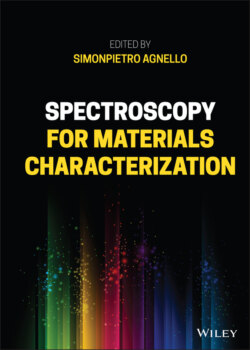Читать книгу Spectroscopy for Materials Characterization - Группа авторов - Страница 2
Table of Contents
Оглавление1 Cover
2 Title Page
3 Copyright Page
4 Preface
5 List of Contributors
6 1 Radiation–Matter Interaction Principles 1.1 Empirical Aspects of Radiation–Matter Interaction 1.2 Microscopic Point of View 1.3 Instrumental Setups 1.4 Case Studies References
7 2 Time‐Resolved Photoluminescence 2.1 Introduction to Photoluminescence Spectroscopy 2.2 Experimental Methods and Analysis 2.3 Case Studies: Luminescent Point Defects in Amorphous SiO2 References
8 3 Ultrafast Optical Spectroscopies 3.1 Femtosecond Spectroscopy: An Overview 3.2 Ultrafast Optical Pulses 3.3 Transient Absorption Spectroscopy 3.4 Ultrafast Fluorescence Spectroscopies 3.5 Femtosecond Stimulated Raman Spectroscopy 3.6 Case Studies References
9 4 Confocal and Two‐Photon Spectroscopy 4.1 Introduction and Historical Perspectives 4.2 Fluorescence Imaging 4.3 Spectroscopy Using a Microscope 4.4 Case Studies References
10 5 Infrared Absorption Spectroscopy 5.1 Fundamentals 5.2 Sources and Detectors 5.3 Techniques and Sampling Methods 5.4 Applications and Case Studies References
11 6 Raman and Micro‐Raman Spectroscopy 6.1 Basic Theory 6.2 Instrumentation 6.3 Case Studies References
12 7 Thermally Stimulated Luminescence 7.1 Theory of Thermally Stimulated Luminescence 7.2 Data Analysis Methods 7.3 Instrumentation and Considerations on Samples 7.4 Case Studies References
13 8 Spectroscopic Studies of Radiation Effects on Optical Materials 8.1 Introduction 8.2 Radiation‐Induced Effects on Optical Materials and Optical Fibers 8.3 Radiation‐Induced Attenuation Measurements 8.4 Radiation‐Induced Luminescence (RIL) 8.5 Case Studies References
14 9 Electron Paramagnetic Resonance Spectroscopy (EPR) 9.1 Introduction 9.2 Basic Principle of EPR 9.3 Anisotropy of g and Spectral Lineshape 9.4 The EPR Lineshape in Powder or in Amorphous 9.5 Hyperfine Interactions 9.6 Paramagnetic Center with S = 1 9.7 Basics of Continuous Wave EPR Setup 9.8 Parameters for EPR Signal Acquisition 9.9 Cw EPR Case Studies 9.10 Time‐Resolved EPR Spectroscopy References
15 10 Nuclear Magnetic Resonance Spectroscopy 10.1 Introduction 10.2 NMR General Concepts 10.3 Liquid‐State NMR 10.4 Solid‐State NMR 10.5 Nonconventional NMR Techniques 10.6 Case Studies References
16 11 X‐Ray Absorption Spectroscopy and X‐Ray Raman Scattering Spectroscopy for Energy Applications 11.1 Introduction 11.2 The X‐Ray Absorption Coefficient and the EXAFS Technique 11.3 EXAFS: Data Analysis Overview 11.4 Experimental Setups 11.5 X‐Ray Raman Scattering Spectroscopy 11.6 Case Studies: Application of XAFS and XRS for Energy Materials References
17 12 X‐Ray Photoelectron Spectroscopy 12.1 General Principles 12.2 Instrumental Setup 12.3 Applications 12.4 Data Analysis 12.5 Case Studies References
18 13 Ultraviolet Photoelectron Spectroscopy – Materials Science Technique 13.1 UPS History and Capabilities 13.2 Theory and Experimental Methodology of UPS 13.3 UPS Experiment and Factors of Influence References
19 14 Transmission Electron Spectroscopy 14.1 Empirical Aspects of Electron–Matter Interaction 14.2 Instrumental Setups References
20 15 Atomic Force Microscopy and Spectroscopy 15.1 Introduction 15.2 The AFM Microscope 15.3 Tip–Surface Interaction Forces 15.4 AFM Acquisition Modes 15.5 AFM Spectroscopy 15.6 Case Studies References
21 Index
22 End User License Agreement
